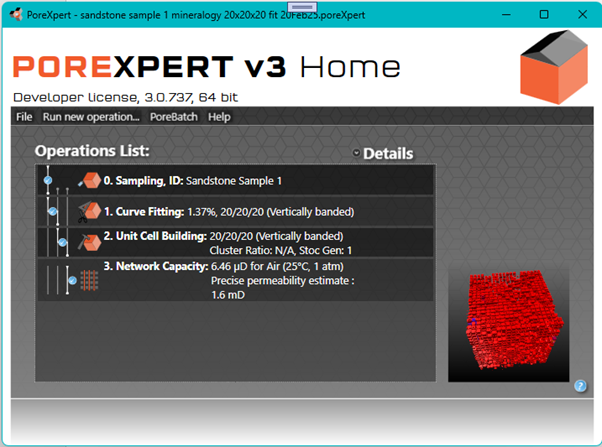The permeability validation exercise provides the starting point for calibrating the permeability estimate generated by PoreXpert. From PoreXpert version 3 onwards, the primary display from the permeability operation is network (flow) capacity, not permeability, recognizing that permeability is a property that is very difficult to simulate, so difficult that a Schlumberger interviewer stated in a personal comment many decades ago that such a calculation was impossible.
Step 1 - calibration datafile
A permeability calibration datafile named permCalibrnParameters.csv is loaded into PoreXpert's learning directory at installation time. If the user is connected to the internet, a check is made every time the program is started to check if there is a more recent version of this datafile available from the PoreXpert website. If there is, it is downloaded and over-writes the version in the learning directory. So if you edit your own calibration datafile, keep a copy of it. Ideally, please send your calibration results to us, suitably anonymised, so that other PoreXpert users can benefit from them if they are working on similar samples.
Version 1 of the datafile is as shown below.

Figure 1. Calibration datafile
Step 2 - comparing with the loaded sample file
In order for an estimate of permeability to be made that is better than the default estimate, additional information about the sample must be provided. In the case of the permeability validation, a simple statistical analysis shows that the common varying factor between the samples was their quartz content. Therefore the calibration was measured against that parameter. Datafiles giving additional information are based on the simple PoreXpert format, with additional information added to row 2. An example is provided in your PoreXpert > Example Files > Experimental Data > Porosimetry directory, entitled sandstone sample 1 mineralogy.csv, The first 9 rows of the 95-row datafile look like this:

Figure 2. The porosimetry datafile containing extra sample information.
The type of sample is shown in the second comma-separated entry in row 2 of the file, i.e. cell B2 in the spreadsheet-style display of Figure 2. So the sample type is porous rock. The first stage of the comparison is to look through the calibration datafile to see if there is the same type of sample, and indeed there is , as shown in cell A5 of Figure 1. Note that the terms must be identical, and the comparison is case sensitive, although padding with spaces does not matter.
Step 3 - what happens if the sample type is recognised
The next check is to see if the sample type subheading can be matched. Again, in this case there is an exact match - both Figure 1 cell B2 and Figure 2 cell C2 state conventional.
Next it looks for an appropriate fitting parameter descriptor, in this case quartz, in Figure 1 cell H5 and Figure 2 cell D2. Then it notes whether the absolute value of the parameter is above zero - i.e. it matters in the fit - in this case the parameter = -2.677 in Figure 1 cell I5, so yes it does matter.
Next it compares mean free paths λ of the mobile fluids used to calculate the permeability - i.e. are the mobile fluid and calibration fluid in the same phase (liquid or gas), and comparable density. If the mean free paths match to within a factor of two, then that is considered exact. All the calibration data within the datafile refer to air at STP (25oC, 1 atm pressure), with a mean free path of 0.07 μm, Figure 1 column C.
The match quality of all the factors considered is summed to give an overall match quality, which is converted into a qualitative estimate of quality.
Step 4 - calculation of the permeability estimate
The only equation type currently available is a polynomial, where :
log10 (calibration factor) = constant parameter1 + parameter1exponent1 + parameter2exponent2 + parameter3exponent3
In the present case, parameters 2 is zero, and parameter 3 is not specified, indicating that the trend line is linear, with parameters as shown in Figure 6 of the void size and permeability validation.
At the end of the estimation, the detail of the fit for this example reads as follows:
Permeability Estimator: sample type match (porous rock), sample subtype match (conventional) , parameter match (quartz) with sample information at position 4, precise match of fluid phase state based on mean free path (0.07 µm compared to 0.072222782 µm)
Fitting equation type: polynomial, First parameter type: constant, value: 3.919
Other parameters: -2.6771, operating on sample parameter value: 0.57 log10CalibrationFactor = 2.393E0, quality of match score = 8/10
This level of detail is not need for the standard output to the user, which in this case is :

Figure 3. Operations List permeability estimate.